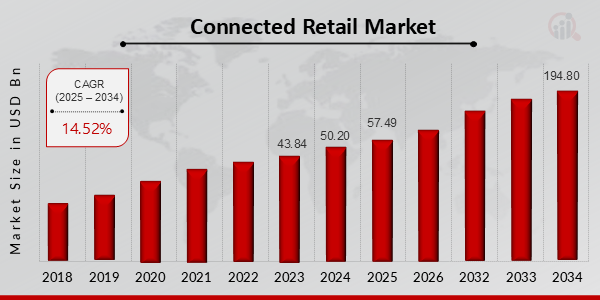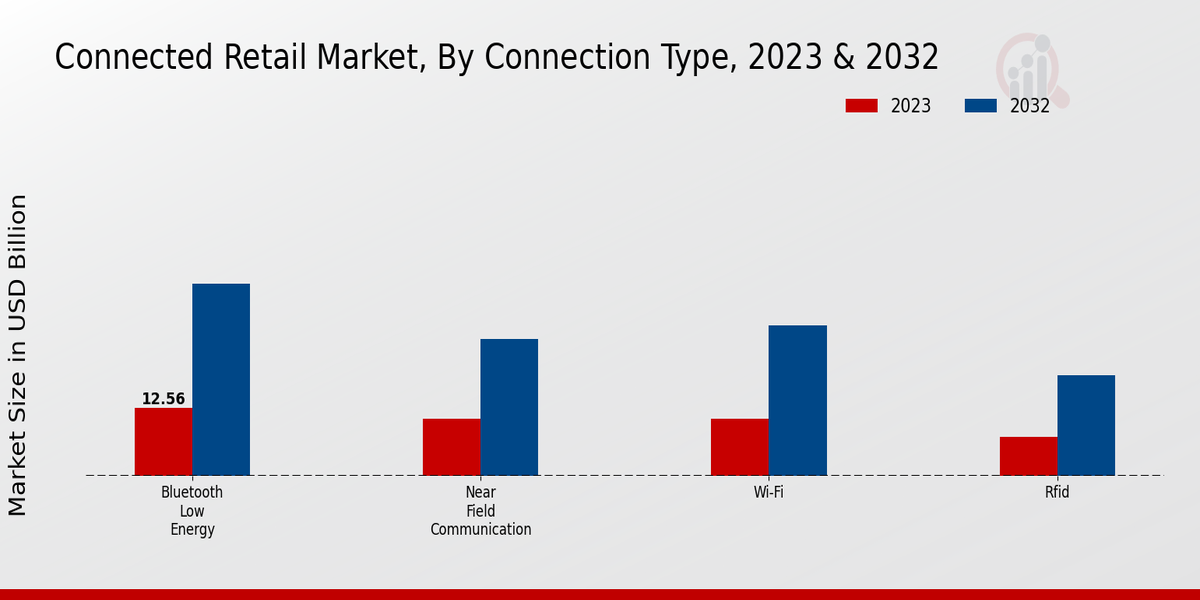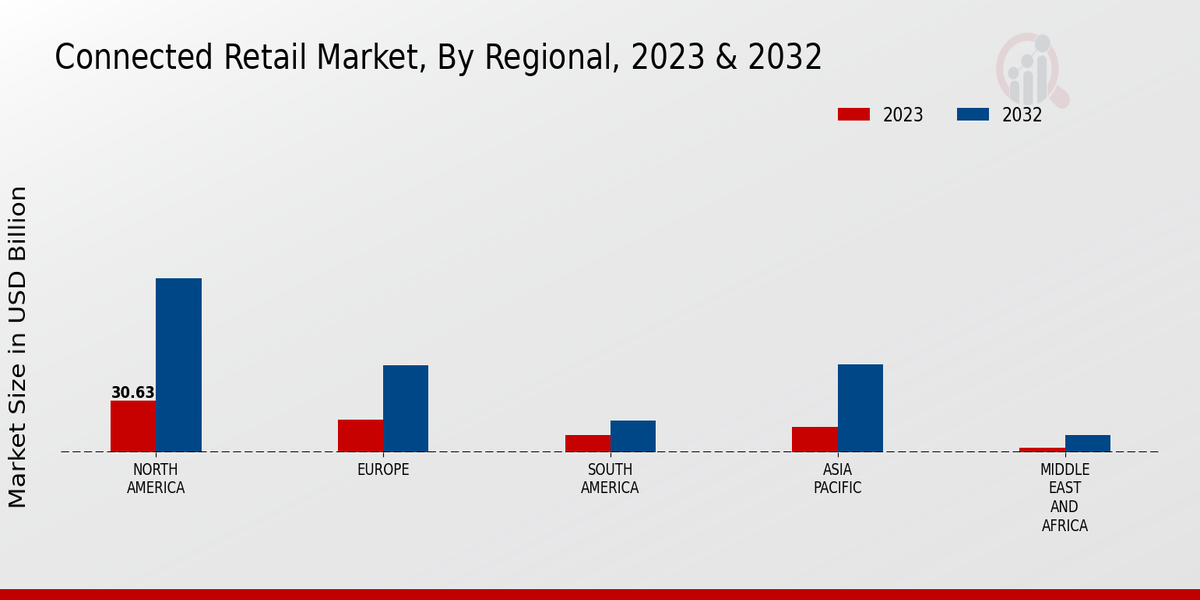Connected Retail Market Overview
Connected Retail Market is projected to grow from USD 57.49 Billion in 2025 to USD 194.80 Billion by 2034, exhibiting a compound annual growth rate (CAGR) of 14.52% during the forecast period (2025 - 2034). Additionally, the market size for Connected Retail Market was valued at USD 50.20 billion in 2024.
Key Connected Retail Market Trends Highlighted
The ascent of omnichannel shopping and the ubiquitousness of mobile devices have catalyzed the surge of connected retail. Consumers expect seamless experiences across physical and digital touchpoints, leveraging technologies like mobile payments, interactive kiosks, and personalized promotions. These innovations enhance the customer journey, providing convenience, efficiency, and tailored offerings.
The growing adoption of AI-powered solutions is another significant trend in connected retail. Retailers leverage AI to analyze customer data, identify trends, optimize inventory management, and personalize marketing campaigns. By leveraging AI's data-driven insights, retailers can deliver highly targeted experiences and meet the evolving needs of their customers.
Furthermore, the convergence of connected retail with emerging technologies like augmented reality (AR) and virtual reality (VR) opens up new opportunities for customer engagement. AR and VR enable shoppers to experience products virtually, enhance their in-store experiences, and foster a more immersive and interactive shopping journey. As these technologies continue to advance, their integration into connected retail is expected to reshape the industry landscape, offering unique and compelling experiences for consumers.
Figure 1: Connected Retail Market Size, 2025-2034 (USD Billion)

Source: Primary Research, Secondary Research, MRFR Database and Analyst Review
Connected Retail Market Drivers
Rising Adoption of Smart Devices and IoT
The proliferation of smartphones, tablets, and other connected devices has fueled the growth of the connected retail market. These devices allow consumers to seamlessly interact with retailers online and offline. The integration of Internet of Things (IoT) technology further enhances the shopping experience by enabling real-time data collection and analysis. Smart sensors and RFID tags can track customer behavior, preferences, and inventory levels, providing valuable insights for retailers to optimize their operations and personalize marketing campaigns.
Increasing Demand for Personalized Shopping Experiences
Consumers today expect personalized and convenient shopping experiences. Connected retail technologies empower retailers to deliver tailored recommendations, loyalty programs, and omnichannel experiences that meet the unique needs of each customer. Artificial intelligence (AI) and machine learning (ML) algorithms analyze customer data to create personalized product recommendations, predict future purchases, and optimize marketing efforts. This results in increased customer satisfaction, loyalty, and repeat purchases, driving the growth of the connected retail market.
Expansion of E-commerce and Omnichannel Retailing
The rapid growth of e-commerce has accelerated the adoption of connected retail solutions. Retailers are leveraging e-commerce platforms to expand their reach, offer a wider selection of products, and provide convenient online shopping experiences. Omnichannel retailing, which seamlessly integrates online and offline channels, is also gaining traction. Connected retail technologies enable retailers to offer a consistent and personalized experience across all touchpoints, from online browsing to in-store purchases and post-purchase support, enhancing customer satisfaction and driving sales.
Connected Retail Market Segment Insights
Connected Retail Market Connection Type Insights
The Connected Retail Market is segmented by Connection Type into Bluetooth Low Energy (BLE), Near Field Communication (NFC), Wi-Fi, and RFID. Bluetooth Low Energy (BLE) is a wireless technology that is designed for low-power consumption. It is often used in connected retail applications, such as beacons, that need to transmit data over short distances. The Connected Retail Market revenue for BLE is expected to reach USD 12.56 billion by 2024, growing at a CAGR of 15.2%. Near Field Communication (NFC) is a wireless technology that allows devices to exchange data over short distances.
It is often used in connected retail applications, such as mobile payments and loyalty programs. The Connected Retail Market segmentation for NFC is expected to reach USD 8.32 billion by 2024, growing at a CAGR of 14.7%. Wi-Fi is a wireless technology that allows devices to connect to the internet. It is often used in connected retail applications, such as in-store Wi-Fi and customer engagement. The Connected Retail Market data for Wi-Fi is expected to reach USD 10.45 billion by 2024, growing at a CAGR of 13.9%. RFID is a wireless technology that uses radio waves to identify and track objects.
It is often used in connected retail applications, such as inventory management and supply chain optimization. The Connected Retail Market Statistics for RFID are expected to reach USD 7.19 billion by 2024, growing at a CAGR of 12.8%. The growth of the Connected Retail Market industry is driven by a number of factors, including the increasing adoption of mobile devices, the growing popularity of online shopping, and the need for retailers to improve the customer experience. The market is expected to continue to grow in the coming years, as retailers invest in new technologies to improve their operations and meet the needs of their customers.

Source: Primary Research, Secondary Research, MRFR Database and Analyst Review
Connected Retail Market Application Insights
The Connected Retail Market is segmented by Application into Inventory Management, Customer Engagement, Analytics and Insights, Payment and Checkout. Inventory Management is expected to hold the largest market share in 2023, due to the increasing need for businesses to track and manage their inventory more efficiently. The Customer Engagement segment is expected to grow at the highest CAGR during the forecast period, due to the increasing adoption of mobile devices and the growing popularity of social media. The Analytics and Insights segment is also expected to grow at a significant rate, as businesses increasingly use data to improve their decision-making.
The Payment and Checkout segment is expected to grow at a moderate rate, due to the increasing adoption of mobile payments and the growing popularity of e-commerce.
Connected Retail Market Deployment Model Insights
The Connected Retail Market is segmented based on deployment model into cloud-based and on-premise. The cloud-based segment accounted for a larger revenue share in 2023 and is projected to maintain its dominance throughout the forecast period. The growth of this segment can be attributed to the increasing adoption of cloud computing services by retailers, owing to its benefits such as scalability, cost-effectiveness, and flexibility. On the other hand, the on-premise segment is expected to witness steady growth during the forecast period due to the preference of some retailers for on-premise solutions due to security and data privacy concerns.
Connected Retail Market End-User Insights
The Connected Retail Market is segmented by End-User into Retailers and Customers. The Retailers segment accounted for the larger market share in 2023 and is projected to continue to lead the market through 2032. The growth of this segment can be attributed to the increasing adoption of connected retail technologies by retailers to improve customer engagement, streamline operations, and enhance the overall shopping experience. The Customers segment is also expected to experience significant growth over the forecast period. The increasing popularity of online shopping, the growing adoption of mobile devices, and the rising demand for personalized shopping experiences are driving the growth of this segment.
This growth is being driven by the increasing adoption of connected retail technologies by both retailers and customers, as well as the growing popularity of online shopping.
Connected Retail Market Regional Insights
The Connected Retail Market is segmented into North America, Europe, APAC, South America, and MEA. Among these regions, North America is expected to hold the largest market share in 2023, owing to the presence of a large number of tech-savvy consumers and early adoption of new technologies. Europe is expected to follow North America in terms of market size, driven by the growing demand for personalized shopping experiences and the increasing adoption of omnichannel retail strategies. APAC is expected to witness the highest growth rate during the forecast period, due to the rising disposable income and the increasing adoption of smartphones and other mobile devices.
South America and MEA are expected to grow at a moderate pace, driven by the increasing urbanization and the growing demand for convenience and personalization.

Source: Primary Research, Secondary Research, MRFR Database and Analyst Review
Connected Retail Market Key Players and Competitive Insights
Major players in the Connected Retail Market are constantly innovating and developing new technologies to gain a competitive edge. The industry is characterized by a high level of competition, with leading Connected Retail Market players investing heavily in research and development. Strategic partnerships and acquisitions are also common in the Connected Retail Market industry, as companies seek to expand their market share and gain access to new technologies.
The competitive landscape of the Connected Retail Market is expected to remain fragmented, with a number of major players and a long tail of smaller companies. Leading Connected Retail Market players are focusing on providing innovative solutions that meet the evolving needs of retailers and consumers. The development of new technologies, such as artificial intelligence and machine learning, is expected to drive the growth of the Connected Retail Market in the coming years.
Amazon is a leading player in the Connected Retail Market. The company offers a wide range of connected retail solutions, including its Amazon Go stores, Amazon Fresh grocery delivery service, and Amazon Prime membership program. Amazon is also investing heavily in developing new technologies, such as artificial intelligence and machine learning, to improve the customer experience. The company's strong brand recognition and extensive customer base give it a competitive advantage in the Connected Retail Market.
Walmart is another leading player in the Connected Retail Market. The company is investing heavily in omnichannel retailing and has developed a number of innovative connected retail solutions, such as its Scan & Go mobile app and its Pickup Towers. Walmart is also expanding its online grocery delivery service and has partnered with Instacart to offer same-day delivery. The company's large store network and loyal customer base give it a competitive advantage in the Connected Retail Market.
Key Companies in the Connected Retail Market Include:
Connected Retail Market Industry Developments
The Connected Retail Market is projected to grow from USD 38.28 billion in 2023 to USD 129.46 billion by 2032, exhibiting a CAGR of 14.5% during the forecast period. Increasing adoption of omnichannel retailing, advancements in IoT and AI technologies, and growing consumer preference for personalized shopping experiences are driving market expansion. Notably, the integration of AR/VR into retail environments to enhance customer engagement is gaining traction.
For instance, in 2023, Amazon launched Amazon Style, a physical store that uses AI-powered mannequins and AR mirrors to provide personalized shopping recommendations. Furthermore, the rising demand for seamless checkout experiences is fueling the adoption of mobile POS systems and self-checkout kiosks. Strategic partnerships and acquisitions are shaping the competitive landscape, such as the 2023 acquisition of retail analytics firm Trax Retail by Zebra Technologies to strengthen its connected retail offerings.
Connected Retail Market Segmentation Insights
-
Connected Retail Market Connection Type Outlook
-
Bluetooth Low Energy (BLE)
-
Near Field Communication (NFC)
-
Wi-Fi
-
RFID
-
Connected Retail Market Application Outlook
-
Inventory Management
-
Customer Engagement
-
Analytics and Insights
-
Payment and Checkout
-
Connected Retail Market Deployment Model Outlook
-
Cloud-Based
-
On-Premise
-
Connected Retail Market End-User Outlook
-
Retailers
-
Customers
-
Connected Retail Market Regional Outlook
-
North America
-
Europe
-
South America
-
Asia Pacific
-
Middle East and Africa
| Report Attribute/Metric |
Details |
|
Market Size 2024
|
50.20 (USD Billion)
|
|
Market Size 2025
|
57.49 (USD Billion)
|
|
Market Size 2034
|
194.80 (USD Billion)
|
|
Compound Annual Growth Rate (CAGR)
|
14.52% (2025 - 2034)
|
|
Report Coverage
|
Revenue Forecast, Competitive Landscape, Growth Factors, and Trends
|
|
Base Year
|
2024
|
|
Market Forecast Period
|
2025 - 2034
|
|
Historical Data
|
2019 - 2023
|
|
Market Forecast Units
|
USD Billion
|
| Key Companies Profiled |
Amazon.com, Inc., SAP SE, Google LLC, Oracle Corporation, Walmart Inc., Infosys Limited, Microsoft Corporation, Cisco Systems, Inc., Accenture plc, IBM Corporation, HCL Technologies Limited, Intel Corporation, Capgemini SE, Wipro Limited, Alibaba Group Holding Limited |
| Segments Covered |
Connection Type, Application, Deployment Model, End-User, Regional |
| Key Market Opportunities |
Personalized shopping experiences frictionless checkout inventory optimization supply chain visibility data analytics |
| Key Market Dynamics |
Rising consumer demand for personalized experiences Technological advancements driving innovation Increasing adoption of IoT and smart devices Growing focus on customer loyalty and engagement Expansion into emerging markets |
| Countries Covered |
North America, Europe, APAC, South America, MEA |
Frequently Asked Questions (FAQ) :
The Connected Retail Market is expected to reach a valuation of USD 194.80 billion by 2034, growing at a CAGR of 14.52% from a base value of USD 57.49 billion in 2025.
Regionally, the market is segmented into North America, Europe, Asia-Pacific, and Rest of the World.
The growth of the market is driven by factors such as the increasing adoption of IoT devices, the rising popularity of e-commerce, and the growing demand for personalized shopping experiences.
Connected Retail finds applications in various sectors, including retail, healthcare, and manufacturing.
Major players in the market include Cisco Systems, IBM, Microsoft, and Oracle.
The market faces challenges such as data security concerns, integration issues, and the lack of skilled professionals.
Opportunities for growth include the development of new technologies, the expansion into emerging markets, and the growing demand for omnichannel experiences.
The Connected Retail Market is expected to grow at a CAGR of 14.52% from 2025 to 2034.
Key trends include the rise of artificial intelligence, the adoption of cloud computing, and the growing importance of sustainability.
Technology advancements are driving the growth of the market by enabling new applications and enhancing customer experiences.

















